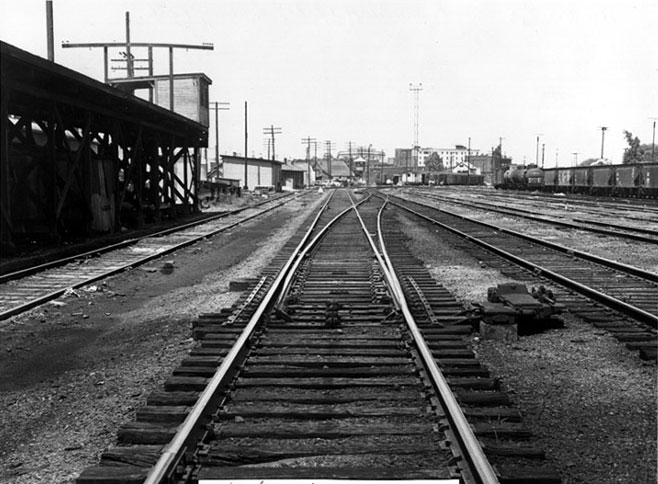|
|||||
| HOME Power Cabooses Rolling Stock MoW Depots | |||||
View from
the Yardmaster's Tower

|
 |
| A view of Missouri Pacific's Centennial Yard from the Yard Masters tower in 1984. Centennial Yard is formerly known as Lancaster Yard from the Texas & Pacific days. - Jay Glenewinkel Photo |
|
First in order: a short description of the duties of those stationed out of the railyard, including a few slang names. Air Monkey - Air brake repairman Car inspector - a.k.a. car knocker, wheel knocker, car toad, car tonk Carman - A person trained in the craft of inspecting and repairing railroad cars. Crew Van Driver - His job was to transport a train crew to and from their locomotive. Though their duties may take them far from the railyard, each driver was assigned to a specific yard. Engine Watchman - his job was to keep water in the boiler and keep enough fire going in the firebox to move the locomotive within the railroad yard. Grease Monkey - An employee who is responsible for greasing frogs, switches and interlocking track equipment. Also a car oiler. Hostler - person working in an engine shed under the operating foreman. The Hostler would go into the yard and pick up an engine from where the journeyman Engineer left it running, and move it into the roundhouse. Yard clerk - a car checker who maintains a listing of freight cars on arriving and departing trains. A.k.a. Mud Hop Switch-engine Engineer - position was held by apprentice engineers learning the trade. Their job was to move cars or rolling stock around the railroad yard. Once the apprentice engineer proved his ability with handling the Switch-engines, the next opening for a Road Engineer would be his. Switchman - works in the railroad yards, hooking cars together, sometimes while the cars were moving. A.k.a. Snake, Iron Bender Wiper - His job was to work a 12 hour shift in the roundhouse, where he packed the internal moving parts of some engineer's beloved engine with grease. Yard Master - a.k.a. yard goat, dinger Yard crew -a.k.a. yard rats, hostler |
 |
| A look at Missouri Pacific's Yard Master Tower in Fort Worth, Texas in 1984. - Jay Glenewinkel Photo |
|
Working
on the Railroad Like railroad crews, the van drivers are assigned to Yards. Even the long haul drivers have a main Yard Base. I first became a
crew van driver in 1992. All the Crew Van Companies are contracted out
by the railroads, however, in a round about way, we do work directly for
the railroads as, as we have railroad radios. and our paperwork is sent
to the railroads. |
|
Railroad
Slanguage Booster
unit - slug
Bowl - The tracks in the Classification Yard where all of the cars are
switched to after being humped. Consist
- The make-up of a freight train by types of cars and their contents.
Frog - The "X" shaped plate of a cross-over rail; also an implement to rerail car wheels. Goat - Switcher engine Gun - A torpedo placed on a rail which will act as a signal warning when it is detonated by a train crossing over it. Hopper - Car with hinged trap doors and inclined floors which permits speedy unloading of certain types of ballast or other material. Hot Box - Overheated wheel journal or wheel bearing which usually causes journal packing to burn and smoke. Hump Yard - A switching yard on an incline where, after movements by the engine, the cars are shunted by gravitational pull to their destination in a yard. Interchange - A track on which various cars are delivered or received from one railroad to another. Ivory
Tower - The main control room where the TMD (Train Movement Directors)
are based. Main Line - That part of a railroad exclusive of switch tracks, branches, yards and terminals. Manifest - Fast freight usually made up of merchandise, perishables or livestock. ME
- Maintenance of Equipment Department Retarder Yard - A switching yard in which the movement of cars, after they are released from a locomotive, are controlled by an employee in a control tower. Rip
Track - Minor car repair siding.
Terminal Facilities - provided by a railroad at a terminus or at any intermediate
point on its line for the handling of passengers or freight, and for the
breaking up, making up, forwarding and servicing trains, and interchanging
with other carriers. Wye - A track in the form of a "Y" which leads from a main line and is used in lieu of a turntable for turning engines, cars and trains around. Yard - A system of tracks within defined area limits for the making up of trains, storing of cars, and for other purposes. |
 |
|
Henderson Avenue looking north, Poplar Bluff, Missouri, 1950 - Craig Meador Collection |
![]()
|
MPRR
Employee Feature Pages
- Input from all former-MPRR Employees welcome!
|
||||
Special Thanks to All the Former Missouri Pacific RR
Engineers and Employees
who have contributed their lives to the Railroad and their unique knowledge
to this site:
James Blagg MPRR Telegrapher-clerk, Concordia and Omaha Sub's, 1973-1987
Bob Currie MPRR Engineer DeQuincy Division, 1972-1990 (engineer 1973-1990)
Daryl W. Favignano MPRR Mechanical Engineering Dept. at St Louis, 1974-1986
Jay Glenewinkel MPRR/UPRR Crew Van Driver, 1992-1997
Nathan Griffin MPRR/UPRR, Hoskins Junction, Clute, Texas, 1975-Today
JD "Tuch" Santucci MPRR Engineer, Dolton and Villa Grove, IL , 1978-1985
Recommended Websites operated by former MPRR Employees:
Bob Currie's MISSOURI PACIFIC DeQuincy Division - MP Engineer
Hot Times
on the High Iron by "Tuch" Santucci - MP Engineer
Missouri
Pacific Railroad Memories by C.E. "Cliff" Satterfield - MP Superintendent
B.M.W.E.
Union, Lodge # 0455/Missouri Pacific System Federation
|
MPRR Employees Service Forum - Devoted to sharing information of former MoPac employees. Feel free to post names or information of those who worked on the railroad -- former MP Employees are Welcome! |
Help Save Lives
Operation
Lifesaver
Railroad Clipart courtesy of
The Ultimate Railroad
Clip Art Library
| All images & text © 2000-2008 T. Greuter / Screaming Eagles, unless otherwise noted. All Rights Reserved. | |